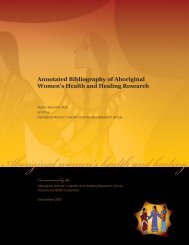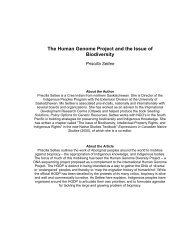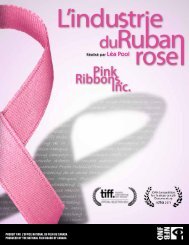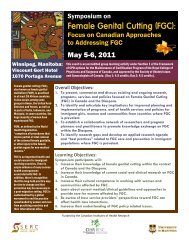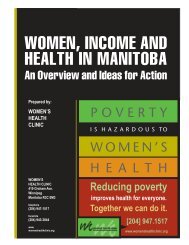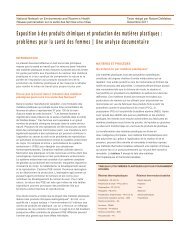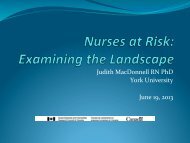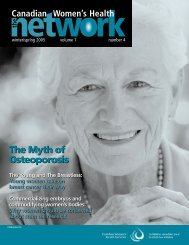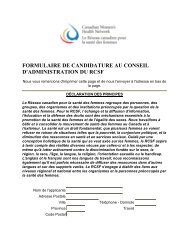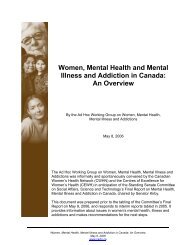NETWORK WIN00 - Canadian Women's Health Network
NETWORK WIN00 - Canadian Women's Health Network
NETWORK WIN00 - Canadian Women's Health Network
You also want an ePaper? Increase the reach of your titles
YUMPU automatically turns print PDFs into web optimized ePapers that Google loves.
THE MYTH OF OSTEOPOROSIS<br />
they offer only marginal or very modest<br />
benefit. Fosamax may reduce hip fractures<br />
by just one percent (although even<br />
this is disputed). In real terms, this<br />
means that 90 at-risk women would<br />
need to be treated for three years to prevent<br />
one hip fracture in one of them.<br />
The remaining 89 would receive no<br />
benefit. It is estimated that hundreds of<br />
women aged 50 years with low bone<br />
density would need to be treated for<br />
more than three years to prevent one<br />
hip fracture in one of the groups.<br />
Leading osteoporosis authority<br />
Professor Ego Seeman of the University of<br />
Melbourne, Australia, poses the question:<br />
Should we expose huge numbers<br />
of these women [age 50 and with<br />
low bone density] to a drug, its<br />
costs, inconveniences, side-effects,<br />
when most will not sustain a fracture<br />
had no treatment been given?<br />
That is, most who take the drug<br />
will be exposed to the risk of sideeffects<br />
and costs and receive no<br />
benefit…This is the nature of preventive<br />
medicine; we have to treat<br />
large numbers to avert events in<br />
few. This is why the drugs we use<br />
must be safe—because most<br />
exposed do not benefit, and even<br />
a small number of adverse events<br />
can tip the balance of net benefit<br />
to net harm<br />
(www.medscape.com/viewarticle/<br />
443214).<br />
Although a recent study showed that<br />
bone mineral density continued to<br />
increase with up to 10 years of Fosamax<br />
use, it is not clear that this means a<br />
reduction in fracture. Another recent<br />
study found that osteonecrosis (bone<br />
death) of the jaw following dental procedures<br />
is a new complication of bisphosphonate<br />
therapy. Dr. Ego Seeman<br />
warns, “We still need to answer the following<br />
question: Do drugs that suppress<br />
bone remodelling reduce or increase the<br />
risk of fracture in the long term?”<br />
Unanticipated risks can surface long<br />
after a drug has been approved, as illustrated<br />
by the serious risks now associated<br />
with Hormone Therapy.<br />
These days osteoporosis is no longer<br />
just a “women’s disease.” But the rush to<br />
provide costly and risky medical solutions<br />
for low bone density in large populations<br />
of healthy men and women who<br />
may never suffer from the disease draws<br />
attention away from the very important<br />
issues of preventing falls in the elderly<br />
and diagnosing genuine sufferers.<br />
Alternative approaches<br />
For most people it seems that a reasonably<br />
nutritious diet, healthy lifestyle and<br />
regular exercise are sufficient protection<br />
against future fracture. Since her diagnosis,<br />
my friend Ann has concluded that by<br />
staying informed, and keeping healthy<br />
and fit, she is doing everything she can to<br />
avert fracture when she is older.<br />
What you can do:<br />
■ Educate yourself about bone health.<br />
Understand that a diagnosis of low<br />
bone density (osteopenia) or even<br />
osteoporosis is not sufficient reason<br />
to embark on a treatment regime.<br />
There are many other risk factors for<br />
osteoporosis, most importantly age,<br />
previous fracture and smoking, as<br />
well as prescription drug use such as<br />
corticosteroids and benzodiazepines.<br />
In fact, stopping drugs that increase<br />
risk of falls such as sedatives and hypnotics<br />
is likely a safer and more effective<br />
strategy than adding a drug that<br />
simply increases bone density. Your<br />
doctor can test you for secondary<br />
causes of osteoporosis.<br />
■ Make sure your diet covers the<br />
diverse nutritional needs of bone.<br />
Including calcium, magnesium, vitamin<br />
K, boron, manganese, zinc, copper,<br />
silicon and other nutrients is<br />
ideal. Fresh vegetables, fruits, nuts<br />
and seeds are good sources of these<br />
nutrients. Limit heavy protein and<br />
salt intake, reduce alcohol, don’t<br />
smoke, and for essential vitamin D,<br />
get sunlight on your skin at safe<br />
times of the day. Note: too much<br />
supplemental calcium can be harmful<br />
and there is inadequate evidence that<br />
dairy foods protect against fracture.<br />
■ Exercise often! The force of muscles<br />
pulling against bone stimulates bone<br />
remodelling and formation. Higher<br />
impact activities like running, jumping<br />
and jogging are very effective, but<br />
regular aerobic exercise such as walking<br />
is also beneficial. Weight bearing<br />
exercises, resistance training, and flexibility<br />
and balancing exercises like<br />
Pilates, Tai Chi and yoga are also<br />
important. Research has demonstrated<br />
that we can benefit from exercise<br />
at any age—even centenarians will<br />
experience an increase in strength,<br />
stamina and muscle mass. Exercise<br />
programs have been found to reduce<br />
the frequency of falls in high-risk<br />
older people.<br />
■ Don’t rush into taking drugs that<br />
may influence bone density but at<br />
present have little known benefit in<br />
terms of reducing fractures. <br />
Gillian Sanson is the author of The<br />
Myth of Osteoporosis (MCD Century<br />
Publications 2003).<br />
For more information visit her website at<br />
www.gilliansanson.com<br />
For additional information on osteoporosis<br />
please visit www.cwhn.ca<br />
8 WINTER/SPRING 2005 CWHN <strong>NETWORK</strong>




